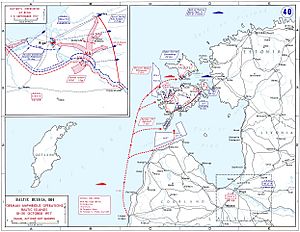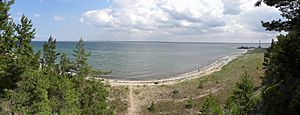Operation Albion facts for kids
Quick facts for kids Operation Albion |
|||||||
|---|---|---|---|---|---|---|---|
| Part of World War I | |||||||
 Operation Albion amphibious operations 12–20 October |
|||||||
|
|||||||
| Belligerents | |||||||
| Commanders and leaders | |||||||
| Strength | |||||||
| 1 battlecruiser 10 dreadnought battleships 9 light cruisers 1 mine cruiser 50 torpedo boats 6 U-boats 19 transports 6 airships 102 combat aircraft 24,500 soldiers 8,500 horses 2,400 vehicles 150 machine guns 54 guns 12 mortars |
2 pre-dreadnought battleships 2 cruisers 1 protected cruiser 21 destroyers 3 gunboats 3 submarines 24,000 soldiers |
||||||
| Casualties and losses | |||||||
| 1 torpedo boat sunk (S 64) 7 minesweepers destroyed 9 trawlers & auxiliary vessels destroyed 5 aircraft shot down 156 killed 60 wounded (Navy) 54 killed 141 wounded (Army) |
1 battleship sunk (Slava) 1 destroyer sunk (Grom) 1 submarine destroyed (HMS C32) Unknown dead and wounded 20,130 captured 141 guns lost (47 heavy guns) 130 machine guns lost 40 aircraft lost |
||||||
Operation Albion was a World War I German air, land and naval operation against the Russian forces in October 1917 to occupy the West Estonian Archipelago. The land campaign opened with German landings at the Tagalaht bay on the island of Saaremaa, on 12 October 1917, after extensive naval operations to clear mines and subdue coastal artillery batteries. The Germans secured the island by 16 October and the Russian army evacuated Muhu on 20 October.
After two failed attempts, the Germans landed on Hiiumaa on 12 October, capturing the island on the following day. The Russian Baltic Fleet had to withdraw from the Suur Strait after its losses at the Battle of Moon Sound. The Germans claimed 20,000 prisoners and 100 guns captured during Operation Albion from 12 to 20 October.
Strategic significance
At the beginning of World War I the islands were of little importance to the Russian Empire or Germany. After the revolutionary turmoil in Russia during the early part of 1917, the German high command believed capturing the islands would outflank Russian defences and lay Petrograd (St. Petersburg) vulnerable to attack.
Order of battle
German units
- Naval Forces (Sonderverband): Vice Admiral Ehrhard Schmidt
- Battlecruiser: Moltke (flagship)
- III Battle Squadron (III. Geschwader) (Vice Admiral Paul Behncke) dreadnought battleships: König (flagship), Bayern, Grosser Kurfürst, Kronprinz, Markgraf
- IV Battle Squadron (IV. Geschwader) (Vice Admiral Wilhelm Souchon) dreadnought battleships: Friedrich der Grosse (flagship), König Albert, Kaiserin, Prinzregent Luitpold, Kaiser
- II Cruiser Squadron (II. Aufklärungsgruppe) (Rear Admiral Ludwig von Reuter) light cruisers: Königsberg (flagship), Karlsruhe, Nürnberg, Frankfurt, Danzig
- IV Cruiser Squadron (VI. Aufklärungsgruppe) (Rear Admiral Albert Hopman) light cruisers: Kolberg (flagship), Strassburg, Augsburg; minelayer: Nautilus; tender: Blitz
- Torpedo Boats (Commodore Paul Heinrich) cruiser: Emden (flagship)
- II Torpedo Boat Flotilla: B 98; 3rd Half-Flotilla: G 101, V 100, G 103, G 104; 4th Half-Flotilla: B 109, B 110, B 111, B 97, B 112
- VI Torpedo Boat Flotilla: V 69; 12th Half-Flotilla: V 43, S 50, V 44, V 45, V 46; 13th Half-Flotilla: V 82, S 64 , S 61, S 63, V 74
- VIII Torpedo Boat Flotilla: V 180; 15th Half-Flotilla: V 183, V 185, V 181, V 184, V 182; 16th Half-Flotilla: S 176, S 178, G 174, S 179, V 186
- X Torpedo Boat Flotilla:: S 56; 19th Half-Flotilla: T 170, T 169, T 172, G 175, T 165; 20th Half-Flotilla: V 78, V 77, G 89, S 65, S 66
- VII Half-Flotilla: T 154, T 158, T 157, T 151, T 160, T 145, T 140, T 139
- Courland Submarine Flotilla (U-BootsFlottille Kurland): UC 56, UC 57, UC 58, UC 59, UC 60, UC 78
- Minesweepers (Minensuchdienst)
- II Minesweeper Flotilla: A 62; 3rd Half-Flotilla: T 136, M 67, M 68, M 75, M 76, M 77, T 59, T 65, T 68, T 82, T 85; 4th Half-Flotilla: T 104, T 53, T 54, T 55, T 56, T 60, T 61, T 62, T 66, T 67, T 69; 8th Half-Flotilla: M 64, M 11, M 31, M 32, M 39, A 35
- III Half-Flotilla of the Search Flotilla: T 141, 15 motor-boats
- Mine-Searcher Group of the Outpost Half-Flotilla East: 6 fishing vessels
- I Minesweeper Division (Riga): 11 motor-boats
- II Minesweeper Division: 12 motor-boats
- III Minesweeper Division: 12 motor-boats
- IV Minesweeper Division: 10 motor-boats; outpost boat O 2
- Mine-barrage Breaker group (Sperrbrechergruppe): Rio Parbo, Lothar, Schwaben, Elass
- Anti-Submarine Forces (U-Bootsabwehr)
- Baltic Search Flotilla: T 144; 1st half-flotilla: T 142, A 32, A 28, A 30, 32 fishing vessels; 2nd half-flotilla: T 130, A 31, A 27, A 29, 24 fishing vessels
- Ground Forces: Generalleutnant Ludwig von Estorff
- 42nd Division
- 2nd Infanterie Cyclist Brigade
Russian units
- 425th, 426th and 472nd Infantry Regiments
- Battleships: Tsesarevich, Slava
- Armored cruisers: Admiral Makarov, Bayan
- Destroyers: Desna, Novik, Pobeditel, Zabijaka, Grom, Konstantin
- Gunboats: Chivinetz, Grozyashchi
- Blockship: Lavwija
- Minelayer: Pripyat
British units
- Submarines: HMS C26, HMS C27, HMS C32
See also
- German occupation of Estonia during World War I
- British submarine flotilla in the Baltic



